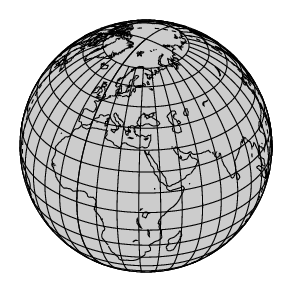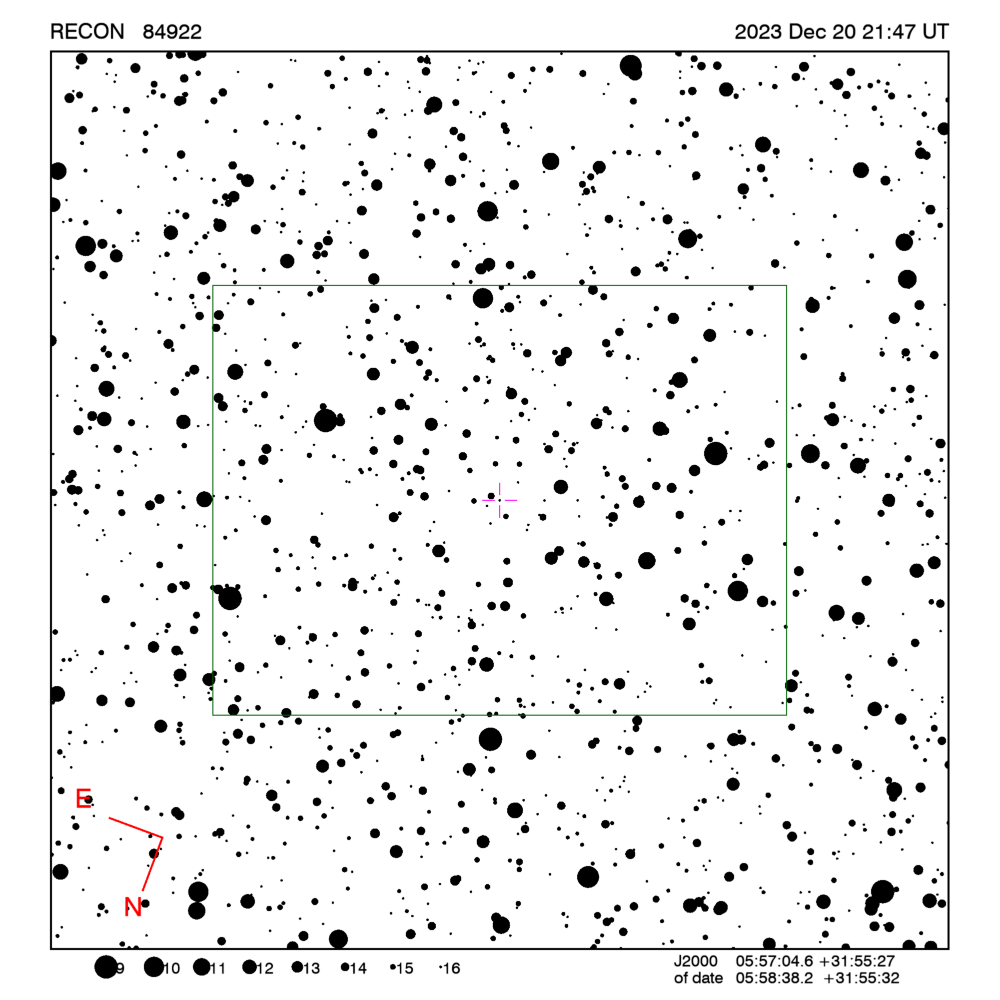RECON: TNO occultation with 84922
Event between (84922) 03VS2 and star GA1200:02121248
with event index number of 2405173
Geocentric closest approach at 2023/12/20 21:47:01 UTC
J2000 position of star is 05:57:04.6 +31:55:27
Equinox of date position of star is 05:58:38.1 +31:55:32
Stellar brightness G=16.7,
use SENSEUP=128 with the MallinCam and and exposure
time of 2 seconds with the QHY174 camera.
Star is 76 degrees from the moon.
Moon is 63% illuminated.
Apparent brightness V=19.6
 Object is 36.9 AU from the Sun
and 35.9 AU from the Earth.
Object is 36.9 AU from the Sun
and 35.9 AU from the Earth.
Apparent velocity is 25.3
km/sec on the sky relative to the star, or,
3.5 arcsec/hr.
The 1-sigma error in the time of the event is 105 seconds.
The 1-sigma cross-track error in the shadow position is
1466 km.
The object has an absolute magnitude Hv=4.0
Diameter=968.3 km assuming a 5% albedo -- 37.9 sec chord
Diameter=395.3 km assuming a 30% albedo -- 15.5 sec chord
Dynamical classification is 3:2E
Star training set for 84922, (2023/12/20 21:47UT)
Object RA Dec mag sep mel
Pollux 07:46:46.8 +27:57:59 1.1 23.70 100
Alnath 05:27:48.6 +28:37:31 1.6 7.43 69
PPM 071002 05:56:32.4 +31:42:10 5.9 0.50 76
PPM 071093 06:01:53.2 +31:56:24 7.9 0.69 77
PPM 071002 05:56:32.4 +31:42:10 5.9 0.50 76
PPM 071029 05:58:27.9 +32:02:16 10.9 0.12 76
84922 05:58:38.2 +31:55:32 16.7 77
Positions are for equinox of date

Azimuth is measured in degrees eastward from north.
North is at an azimuth of 0, due East is at an azimuth
of 90 degrees, due South is 180, and due West is 270.
Do not use the listing below for the RECON CPC 1100 telescopes.
This is provided for other non-team facilities.
Star training set for 84922, (2023/12/20 21:47UT)
Object RA Dec mag sep mel
Pollux 07:45:17.9 +28:01:33 1.1 23.70 100
Alnath 05:26:17.6 +28:36:23 1.6 7.43 69
PPM 071002 05:54:58.9 +31:42:02 5.9 0.50 76
PPM 071093 06:00:19.6 +31:56:26 7.9 0.69 77
PPM 071002 05:54:58.9 +31:42:02 5.9 0.50 76
PPM 071029 05:56:54.1 +32:02:11 10.9 0.12 76
84922 05:57:04.6 +31:55:27 16.7 76
Positions are for J2000
Event circumstances last updated at 2023/12/06 05:55:34 UT
Marc W. Buie,
Southwest Research Institute
RECON
 Object is 36.9 AU from the Sun
and 35.9 AU from the Earth.
Object is 36.9 AU from the Sun
and 35.9 AU from the Earth.
